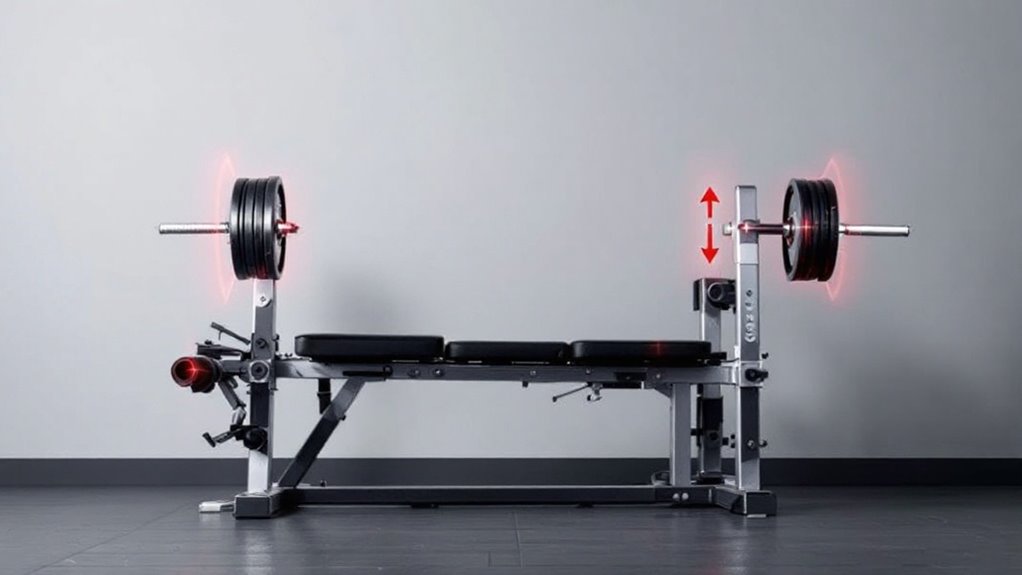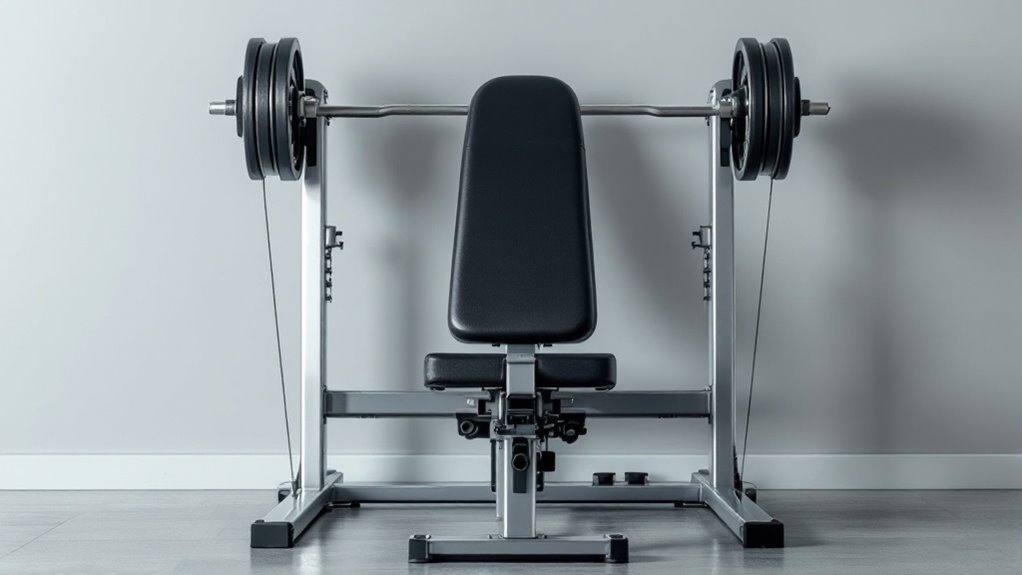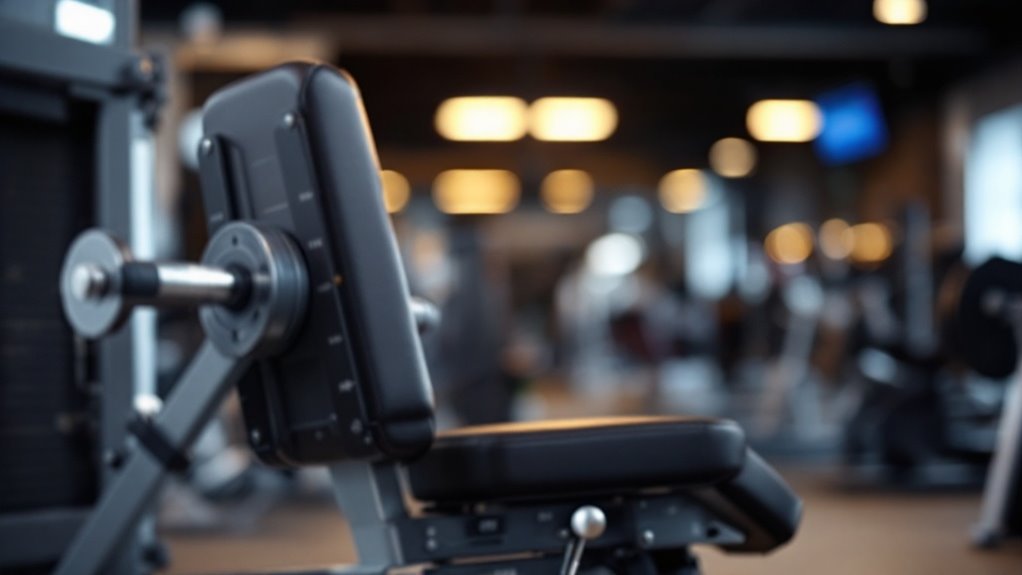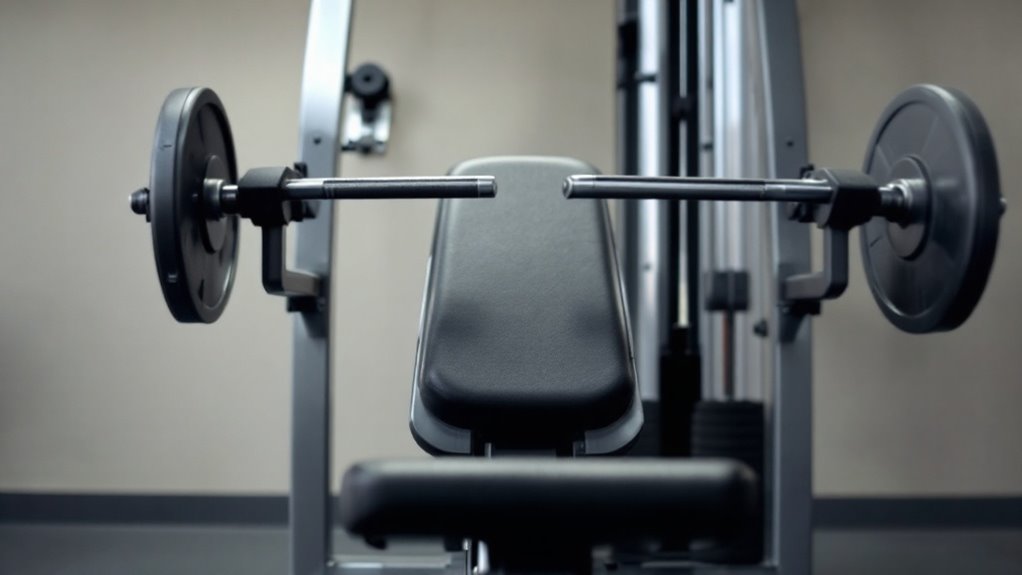Seated Bench Press Machine

The seated bench press machine offers a stable alternative to traditional free weights while effectively targeting the chest, shoulders, and triceps. This equipment provides precise form control through guided movement patterns, reducing injury risk compared to barbell bench pressing. Users can focus on proper technique through adjustable settings and systematic progression. The machine's design enables proper posture and muscle activation for both beginners and advanced lifters. Mastering this equipment reveals new levels of upper body development.
Key Takeaways
- The seated bench press machine targets the chest, shoulders, and triceps while providing better stability and control than free weights.
- Adjust the seat height to chest level, grip handles evenly, and maintain proper posture throughout the movement.
- Control the tempo during pushing and pulling motions while breathing steadily: exhale on push, inhale on return.
- Start with lighter weights to master form before progressively increasing weight or repetitions for continued muscle development.
- Vary grip width and incorporate techniques like pause reps or single-arm presses to target different chest areas.
Muscles Worked and Benefits

The seated bench press machine targets multiple major muscle groups in the upper body while providing a stable and controlled pressing movement.
The machine-guided bench press delivers targeted upper body training through controlled movements, maximizing muscle engagement while minimizing injury risk.
Primary muscles utilized include the pectoralis major (chest), anterior deltoids (front shoulders), and triceps. The machine's guided path activates supporting muscles like the biceps, lateral deltoids, and core stabilizers.
Key benefits include reduced risk of injury compared to free weights, precise form control, and the ability to focus on specific muscle groups.
The machine's adjustable settings allow users to progress systematically while maintaining proper posture. This makes it an excellent choice for beginners and those rehabilitating from injuries.
Following progressive overload principles helps ensure continuous strength gains when using the machine over time.
Proper Form and Technique

Mastering proper form sets the foundation for safe and effective workouts on the seated bench press machine. The first step is adjusting the seat height so that the handles are positioned with mid-chest level.
Keep feet firmly planted on the floor, shoulder-width apart.
When executing the movement, grip the handles with palms facing forward. Maintain a neutral spine by keeping the back pressed against the pad.
Push the handles forward in a controlled motion until arms are extended but not locked. Slowly return to the starting position.
Remember to breathe steadily throughout – exhale while pushing and inhale while returning.
Never sacrifice form for weight.
Following proper progressive overload principles will help maximize strength gains over time.
Common Mistakes to Avoid

Despite the seated bench press machine's straightforward design, users commonly make mistakes that can compromise results and increase injury risk. Proper attention to form and awareness of potential errors is essential for maximizing workout benefits. Progressive overload principles are crucial for women to achieve optimal strength gains without fear of excessive muscle bulk.
| Common Mistake | Consequence | Correction |
|---|---|---|
| Rushing movements | Reduced muscle involvement | Control tempo |
| Uneven grip | Muscle imbalance | Position hands equally |
| Partial range | Limited gains | Full extension |
| Excessive weight | Poor form/injury | Start lighter |
Training Tips and Variations

Maximizing results on the seated bench press machine requires strategic training approaches and thoughtful variations to keep workouts challenging and effective.
Key training tips include implementing drop sets, where weight is gradually decreased to extend the set beyond initial failure. Alternating grip widths targets different areas of the chest muscles.
For variation, trainers can incorporate pause reps, tempo changes, and single-arm presses. Advanced users can experiment with rest-pause training, partial reps at the end of sets, and mechanical drop sets by adjusting the seat position.
These modifications prevent plateaus and maintain steady progress while reducing the risk of form breakdown.
Following the principle of progressive overload, gradually increase the weight or reps to continuously challenge your muscles and promote growth.
Frequently Asked Questions
Can Pregnant Women Safely Use the Seated Bench Press Machine?
Pregnant women should consult their healthcare provider before using any resistance training equipment.
Generally, the seated bench press machine can be safe during early pregnancy if the woman has prior experience. However, as pregnancy progresses, modifications may be needed due to changing center of gravity and joint laxity.
Alternative exercises like resistance bands or lighter weights might be more suitable during later trimesters.
What Is the Average Lifespan of a Seated Bench Press Machine?
According to fitness equipment industry data, commercial-grade bench press machines handle an average of 7,000 user sessions annually.
A well-maintained seated bench press machine typically lasts 8-12 years in a commercial gym setting and 15-20 years in home environments.
Regular maintenance, including quarterly bolt tightening, cable inspection, and bearing lubrication, considerably extends the equipment's lifespan.
High-end models from reputable manufacturers often carry 10-year structural warranties.
How Much Space Do I Need in My Home Gym?
A home gym requires a minimum of 10 x 10 feet for basic equipment setup.
For a complete workout space, 15 x 20 feet is ideal.
Factor in ceiling height of at least 8 feet for overhead exercises.
Consider additional clearance around equipment for safe movement and proper form.
Remember to account for equipment footprint, storage space, and adequate ventilation.
A well-planned layout enhances workout efficiency and safety.
Is the Seated Bench Press Machine Suitable for Children Under 16?
While strength training can benefit growing bodies, the seated bench press machine isn't generally recommended for children under 16.
Their developing musculoskeletal system requires more natural movement patterns. Instead, bodyweight exercises like push-ups and supervised resistance band training are safer options.
If a teen shows interest in weight training, proper form instruction and starting with lighter free weights under qualified supervision is preferable for long-term athletic development.
Can People With Shoulder Replacements Use This Machine Safely?
Individuals with shoulder replacements should consult their surgeon and physical therapist before using any chest press machine.
While the seated position provides stability, the fixed movement pattern may not accommodate post-surgery biomechanics.
If cleared by medical professionals, users should start with minimal weight, focus on proper form, and monitor for any discomfort or unusual sensations.
Alternative exercises might be recommended during initial recovery phases.
Final Thoughts
Like a well-oiled machine, the seated bench press machine remains a reliable cornerstone in any strength training program. Its controlled motion, targeted muscle involvement, and adjustable resistance make it an essential tool for both beginners and experienced lifters. When executed with proper form and integrated thoughtfully into a workout routine, this machine can help lifters build impressive upper body strength while minimizing injury risk.


